Frozen sales meet ballooning inventories.
By Wolf Richter for WOLF STREET.
Pending home sales are a forward-looking indicator of “closed sales” of existing homes to be reported over the next couple of months. From the National Association of Realtors today, seasonally adjusted:
- In the West, pending home sales dropped further, marking the worst February in the data going back to 2011, and just above the all-time low of October 2023.
- In the South, pending sales in February rose from the all-time low in January and mark worst February on record.
- In the Northeast, pending sales dipped further, mark worst February on record.
- In the Midwest, pending sales ticked up a hair, mark worst February on record.
So overall US pending home sales ticked up a hair from the record low in January, and also marked the worst February in the data, seasonally adjusted. They’ve been hobbling along the bottom for over two years, pounded down by too-high prices that don’t work at all with the current mortgage rates. Compared to the Februarys in prior years (historic data via YCharts):
- 2024: -3.6%
- 2023: -11.4%
- 2022: -31.4%%
- 2021: -35.1%
- 2020: -35.0%
- 2019: -29.3%.
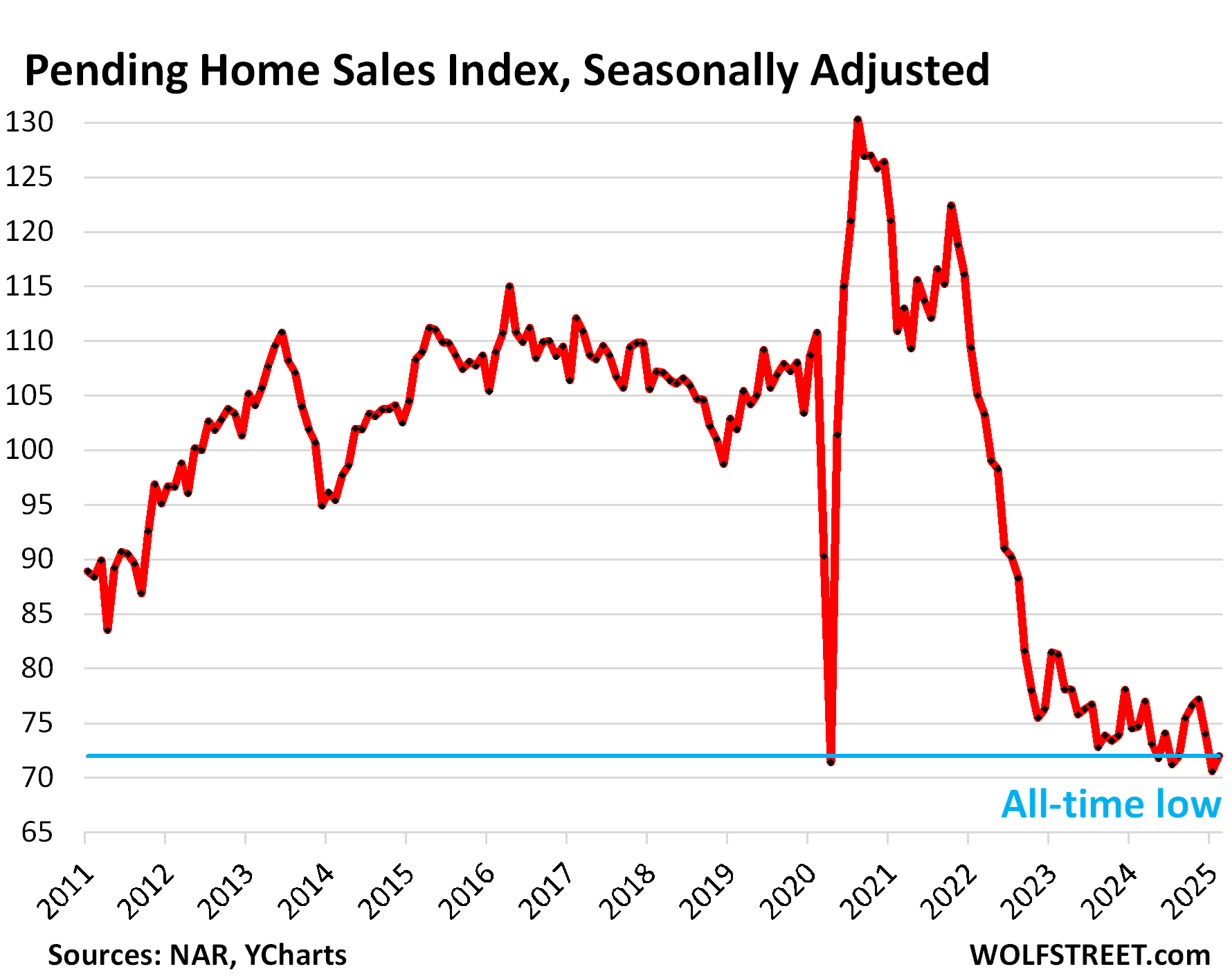
“Considering the Federal Reserve’s recent forecast for slower economic growth, we expect mortgage rates to slide moderately lower,” the NAR said in the report.
“But the current high national debt will prevent mortgage rates from falling drastically – and certainly not to the 4%-to-5% range seen during President Trump’s first term,” the report said.
Even the NAR has given up hopes for low mortgage rates to bail out the housing market.
The average 30-year fixed mortgage rate was 6.5% in the latest reporting week, and has been around 6.5% for four weeks, according to Freddie Mac today. It has been above 6% since September 2022.
Below-5% mortgage rates were brought about by QE and very low inflation. Now there’s the rebirth of the inflationary era, with higher interest rates to compensate lenders for higher inflation; and what NAR pointed out, there’s the huge national debt putting upward pressure on long-term rates, including mortgage rates.
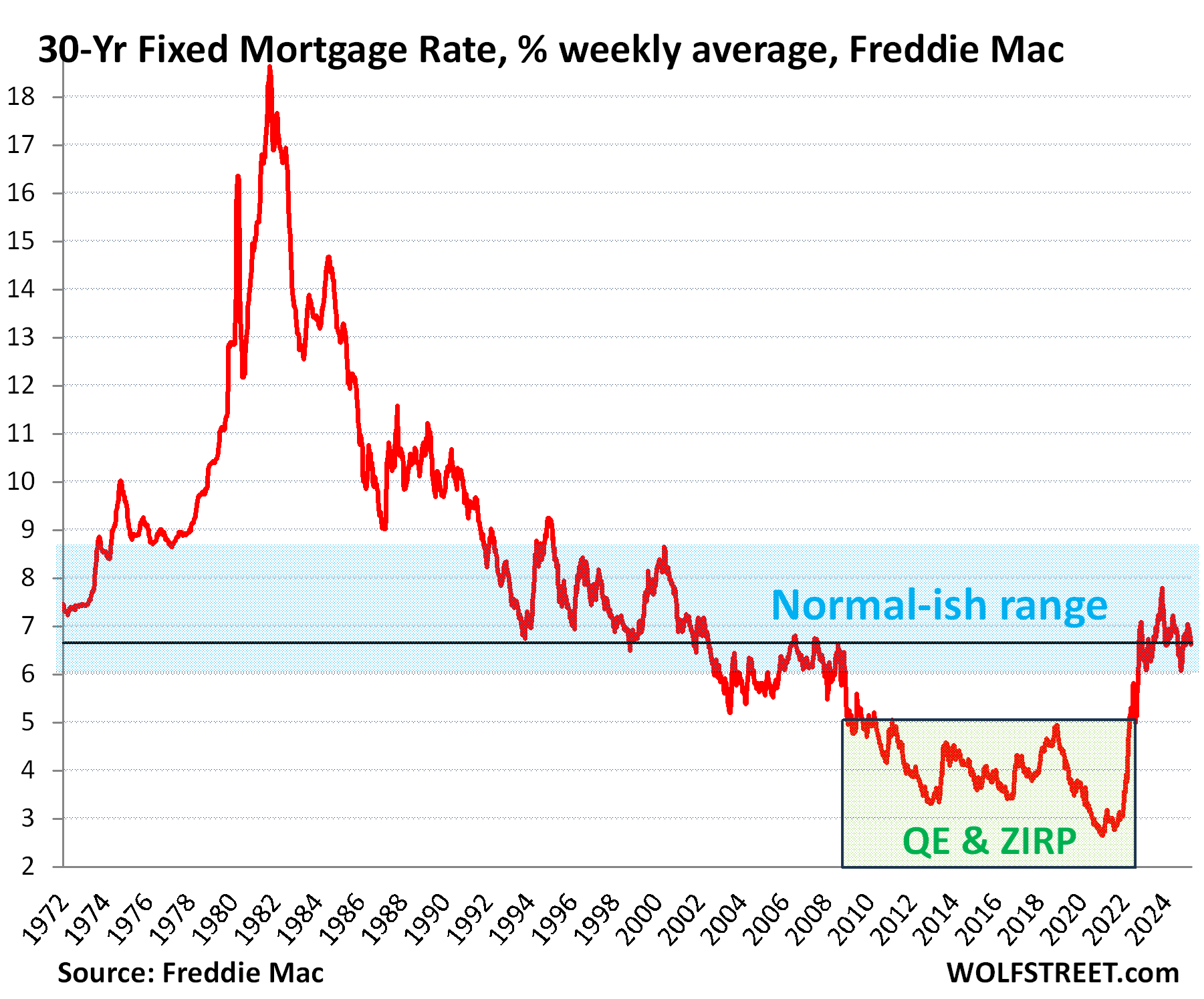
Pending sales are based on contract signings and track deals that haven’t closed yet and could still fall apart or get canceled, for all kinds of reasons, such as buyers being unable to afford or even get homeowner’s insurance, or financing falling through. Signed contracts that eventually fall apart are included in pending sales, but not in the figures of closed sales reported later.
In the South: frozen sales, ballooning inventories.
Pending sales rose 6.2% in February from the all-time low in January, seasonally adjusted, marking the worst February in the data.
It’s precisely in the South where inventories for sale of new houses and existing homes are now piling up.
Pending sales in February compared to the Februarys in prior years (historic data via YCharts):
- 2024: -3.4%
- 2023: -12.1%
- 2022: -32.2%
- 2021: -35.3%
- 2020: -33.5%
- 2019: -28.7%.
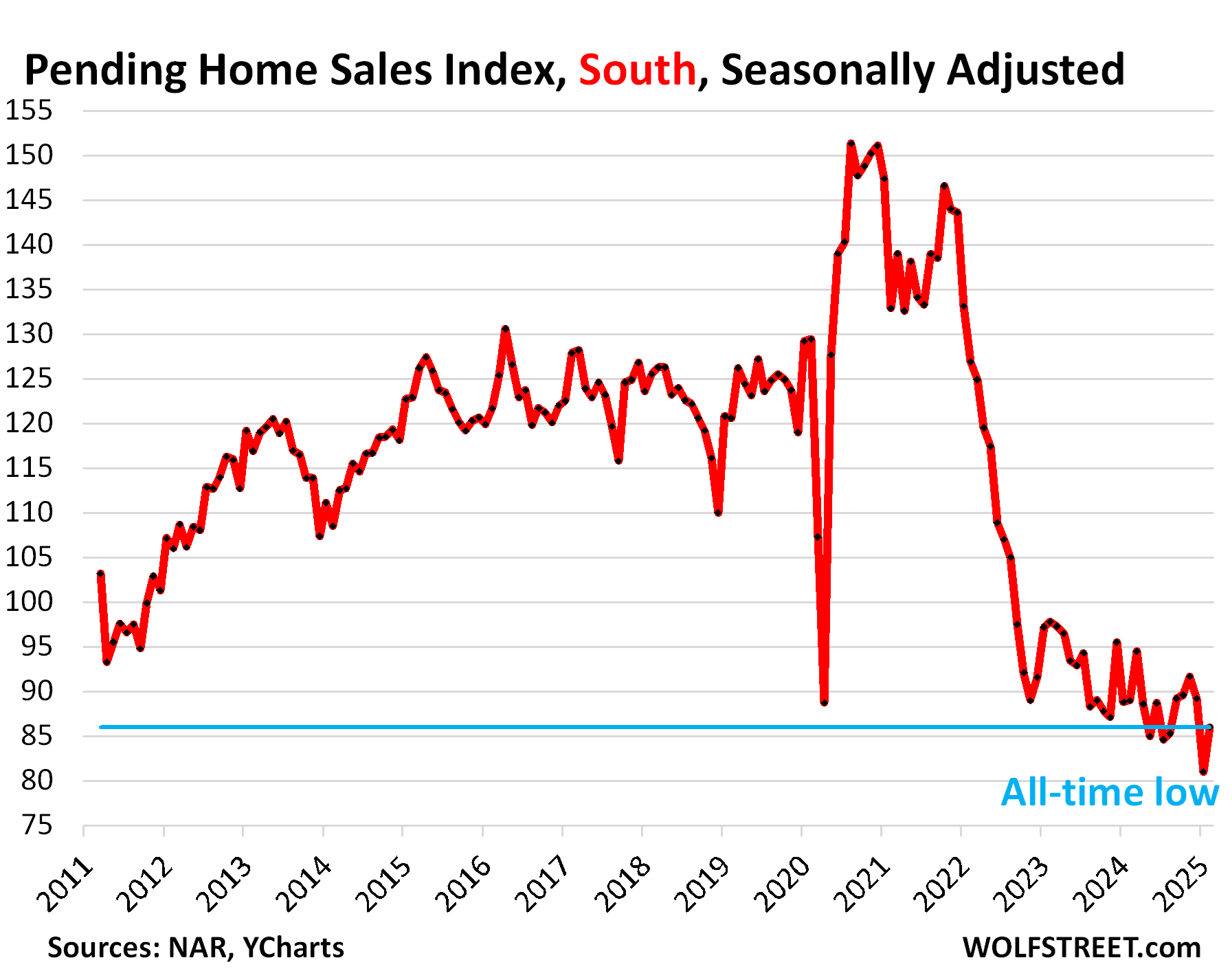
Inventories of existing homes surged in Florida and Texas. In terms of transactions, Florida is the largest housing market in the US. Florida and Texas dominate the vast South (map of regions in the comments below). And that’s where inventories of existing homes are ballooning, which is a good thing because the housing market needs these inventories.
In Florida, active listings of existing homes surged by 34% year-over-year in February, to 168,717 listings, the highest in the data by Realtor.com going back to 2016.
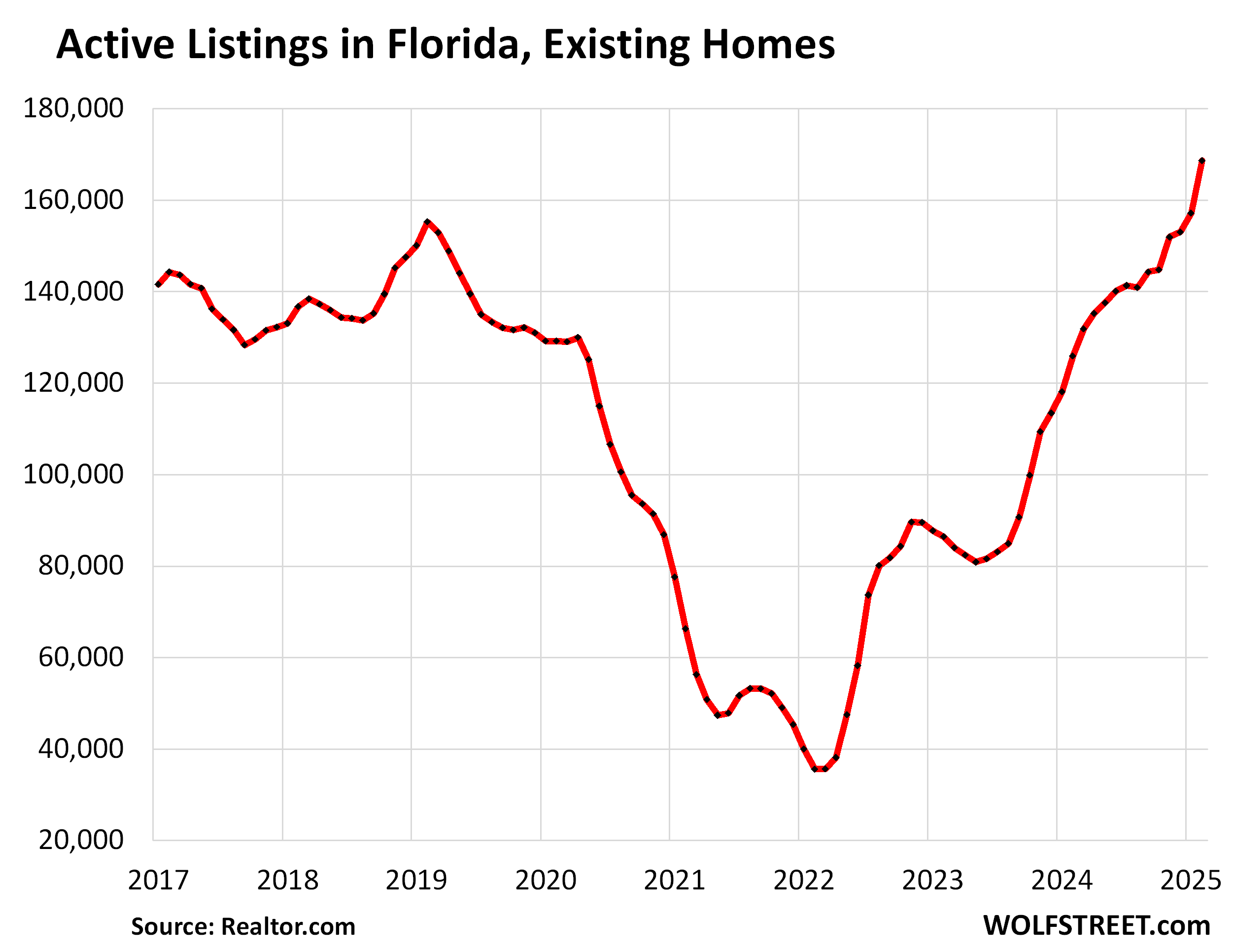
In Texas, active listings of existing homes jumped by 25% year-over-year in February, to 105,867 listings, the highest for any February in the data by Realtor.com going back to 2016.
Active listings in Texas are highly seasonal: lows in January/February, highs in July/August. So we look at the stacked chart (big red squares = January and February 2025).
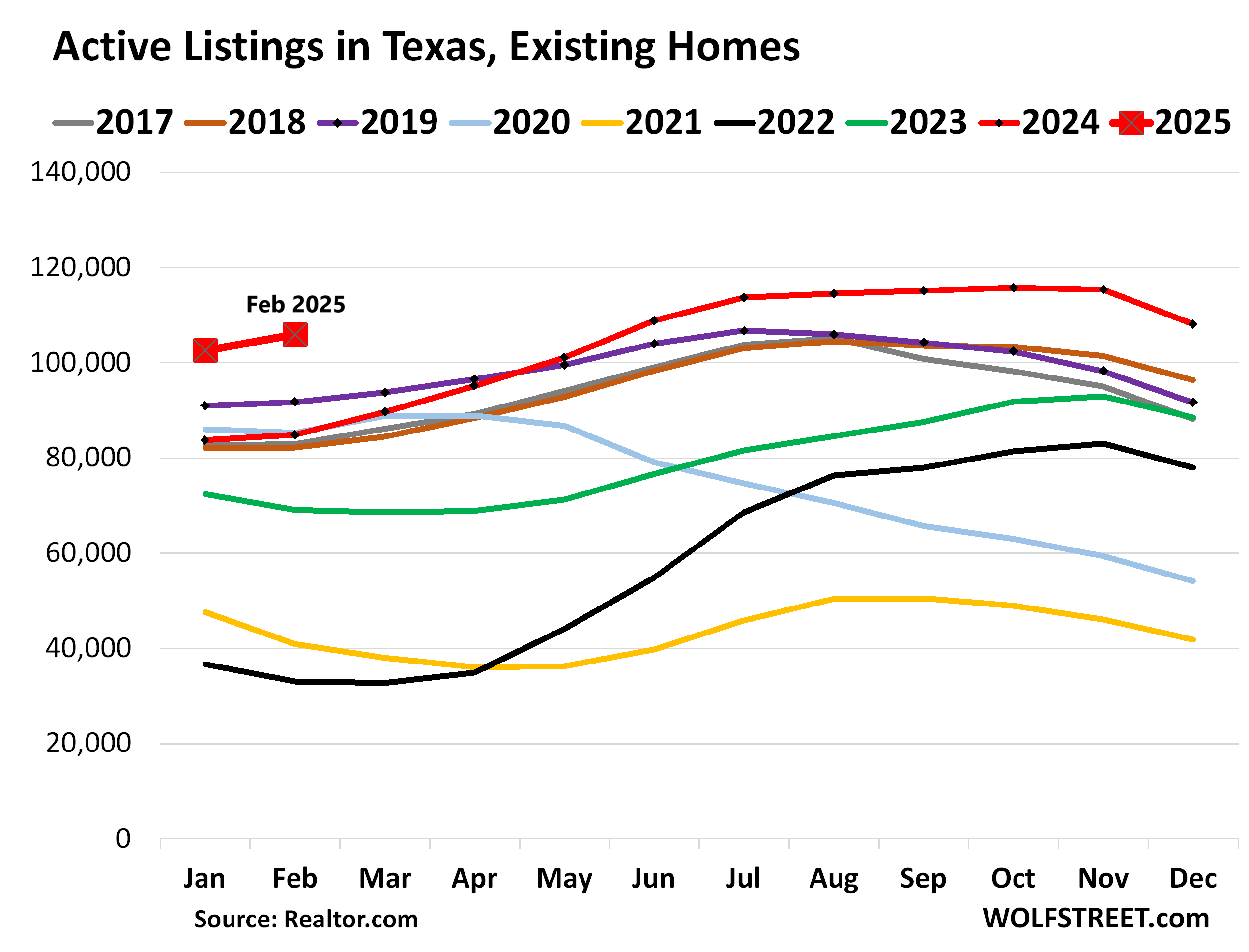
New single-family houses for sale in the South have ballooned past the Housing-Bust high since mid-2024 to a range between 290,000 to 304,000 houses for sale. In February, 296,000 new houses were for sale in the South, up by 72% from February 2019!
Massive incentives and lower prices by homebuilders have stimulated sales in the South, and in February, sales were up by 18% year-over-year. That’s what it takes to cure the issues of this housing market: lots of new inventory and lower prices.
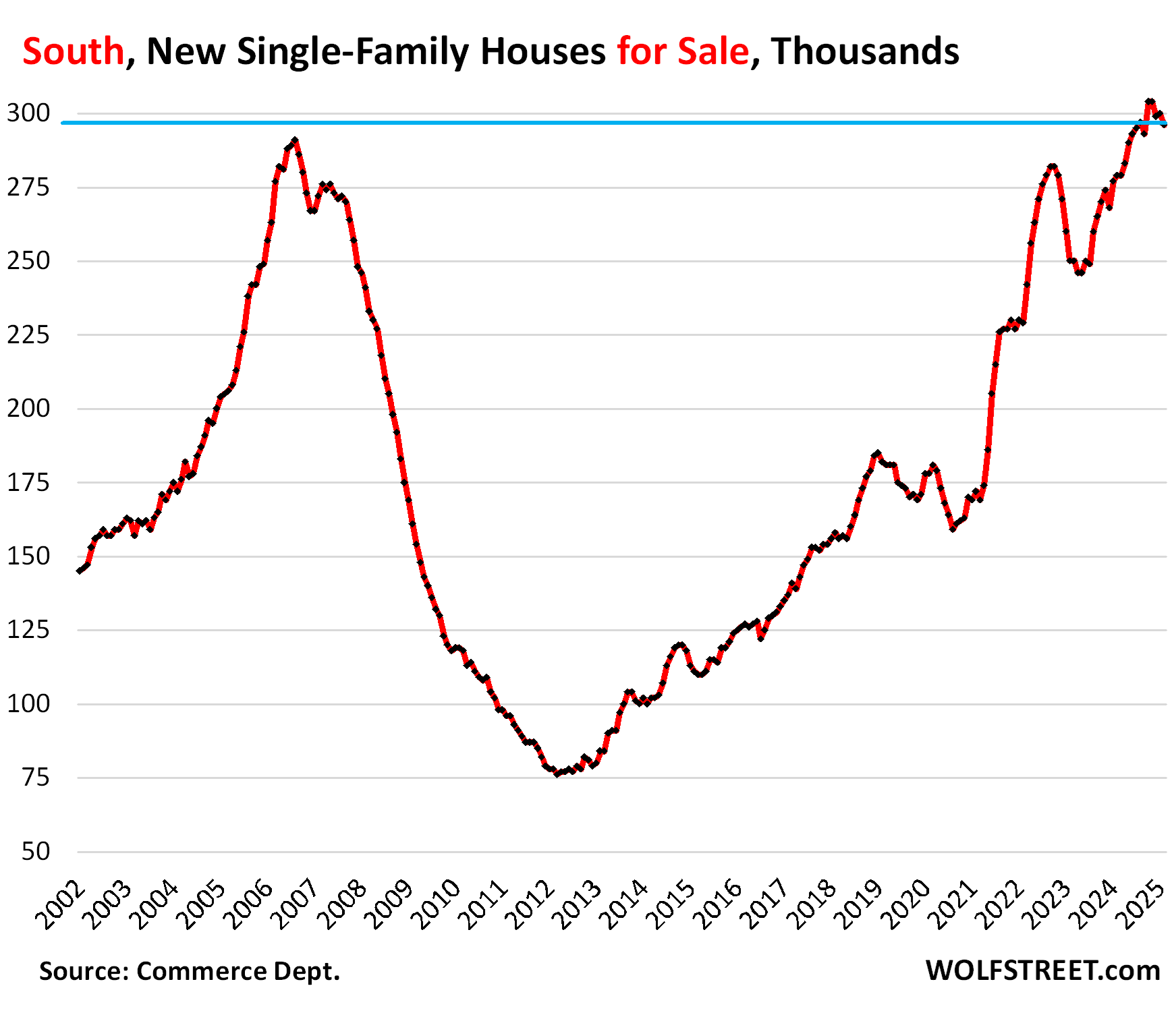
In the West, frozen sales, ballooning inventories.
Pending sales of existing homes dropped 3.0% in February, to the second lowest levels behind only the all-time low of October 2023, marking the worst February in the data, seasonally adjusted.
Compared to the Februarys in prior years (historic data via YCharts):
- 2024: -3.5%
- 2023: -9.8%
- 2022: -37.9%
- 2021: -41.2%
- 2020: -41.2%
- 2019: -36.1%.
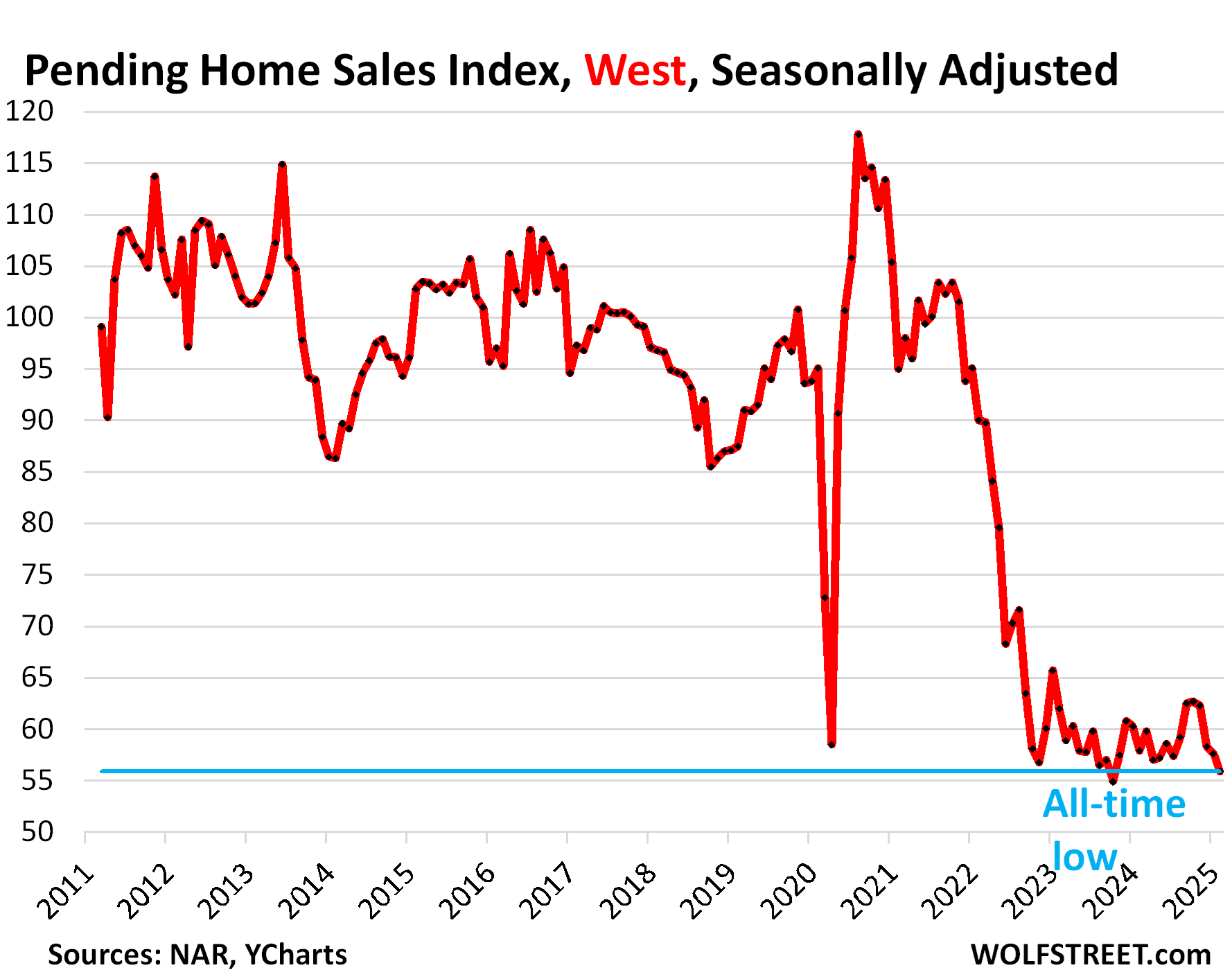
Inventory of existing homes in the West varies by area, and California may not be the most representative example of the West, but it’s by far the largest market in the West. So we’ll take a look.
Active listings of existing homes in California spiked by 43% in February from a year ago, to 52,144 homes, the highest February since 2019, and just a hair below February 2018 (big red squares = January and February 2025).
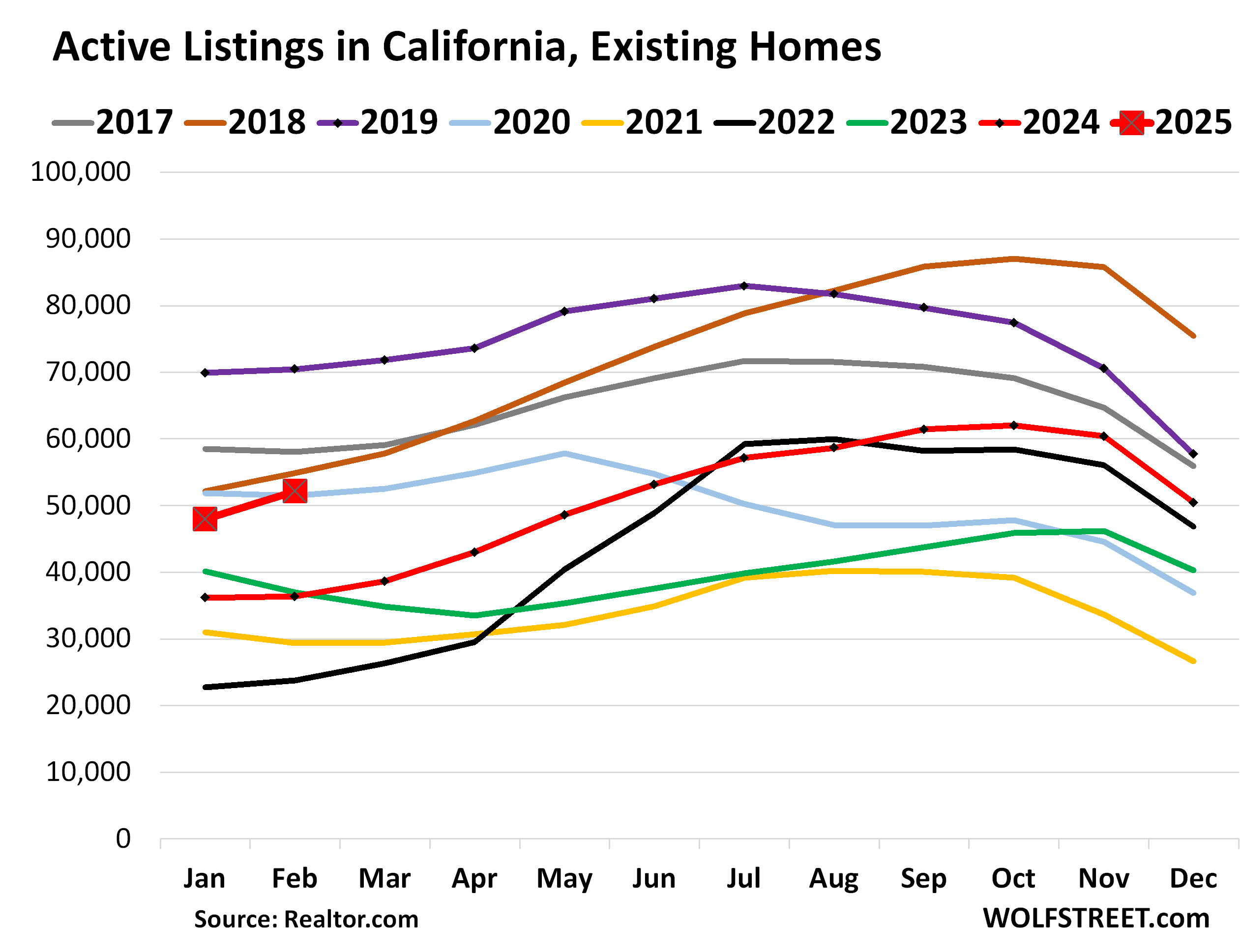
Inventory of new single-family houses surged in the West to 120,000 houses, the highest level since December 2007, and up by 60% from 2019.
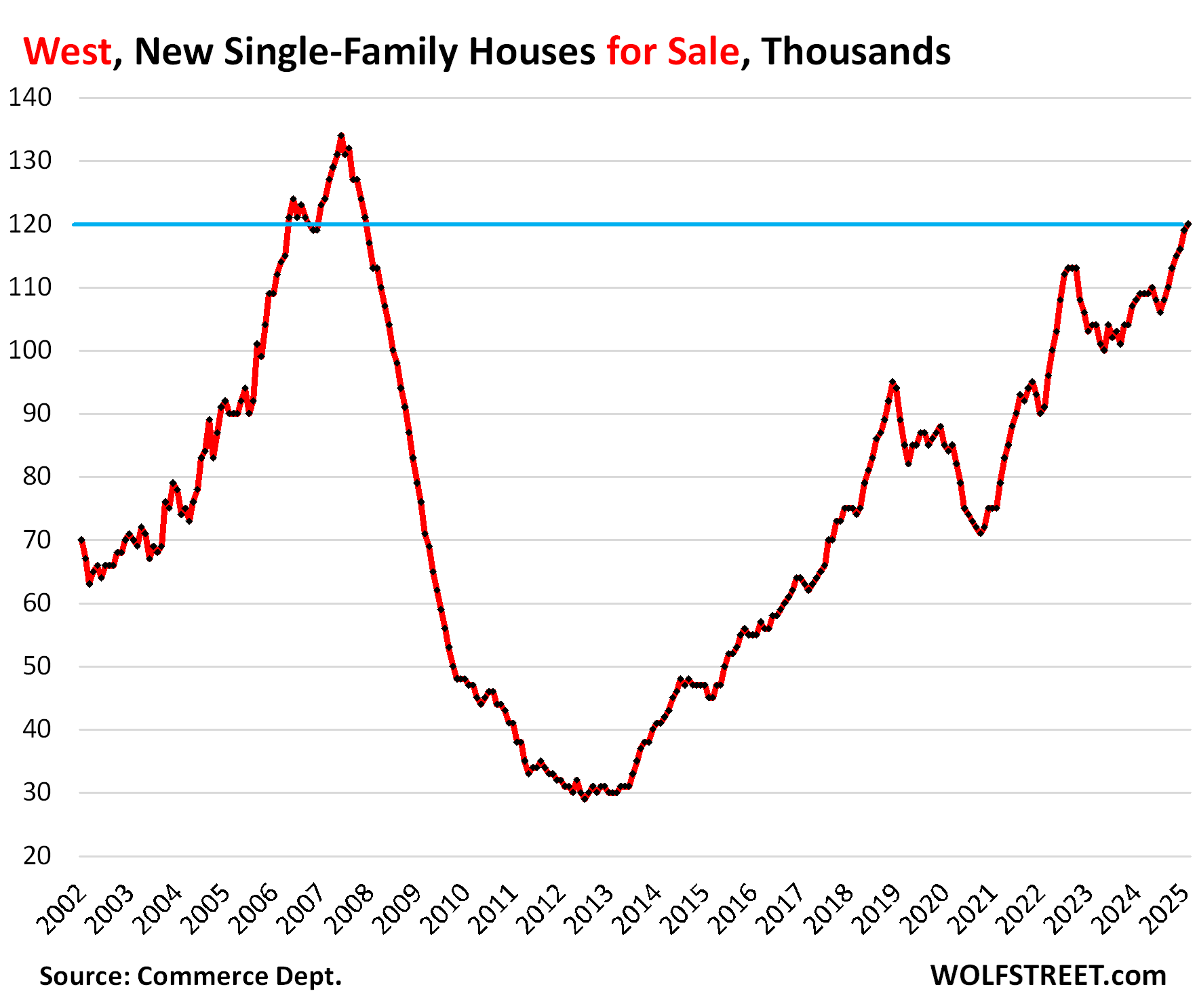
Pending sales in the Northeast and Midwest.
In the Northeast, pending sales of existing homes fell by 0.9% in February from January, seasonally adjusted, the worst February in the data, and the third-worst month overall after August 2024 and Lockdown-April 2020.
Compared to the Februarys in prior years (historic data via YCharts):
- 2024: -2.5%
- 2023: -9.9%
- 2022: -26.9%
- 2021: -33.6%
- 2020: -34.6%
- 2019: -31.8%.
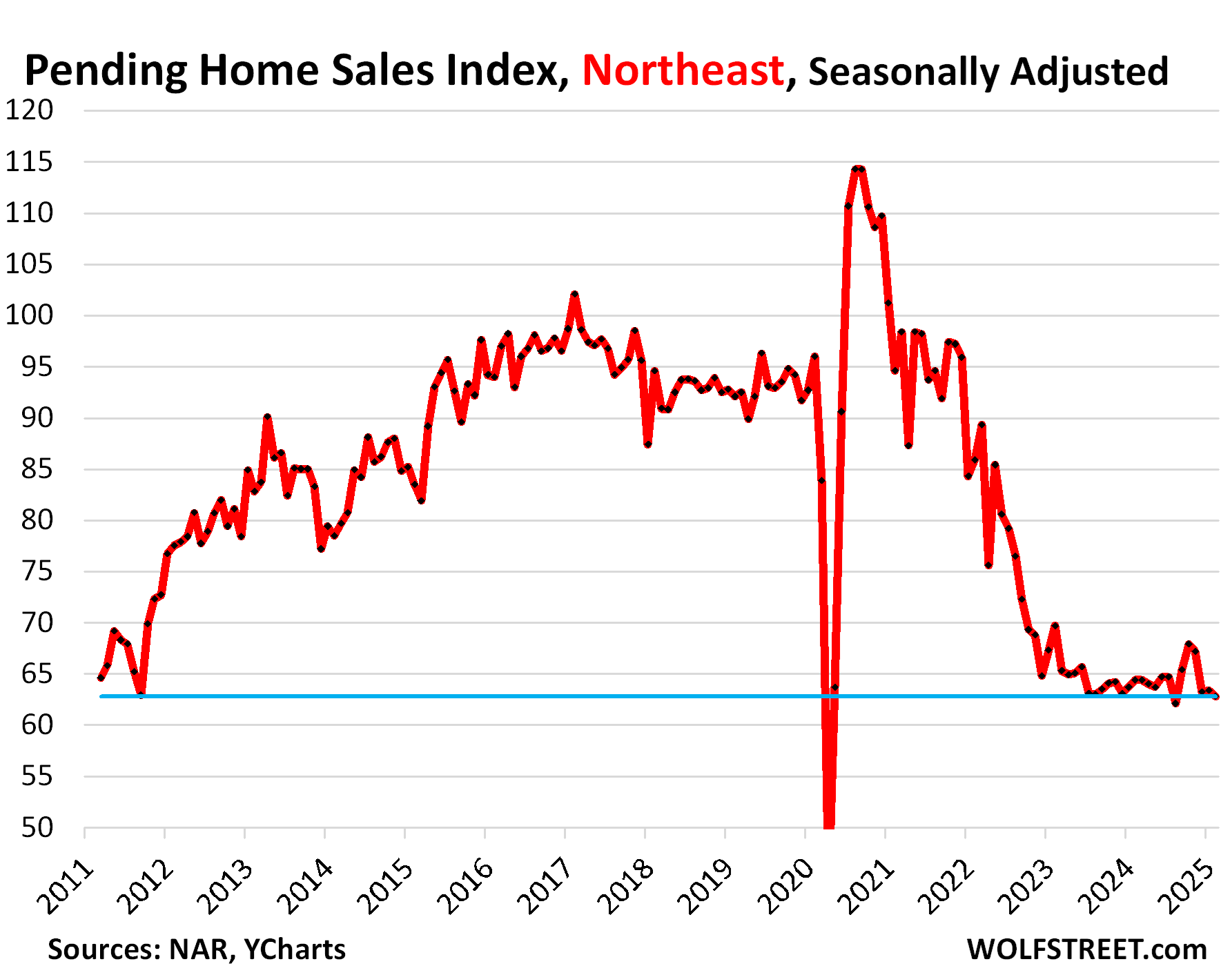
In the Midwest, pending sales rose by 0.7% in February from January, seasonally adjusted, marking the worst February in the data.
Compared to the Februarys in prior years (historic data via YCharts):
- 2024: -4.7%
- 2023: -12.4%
- 2022: -27.3%
- 2021: -30.3%
- 2020: -32.8%
- 2019: -21.4%.
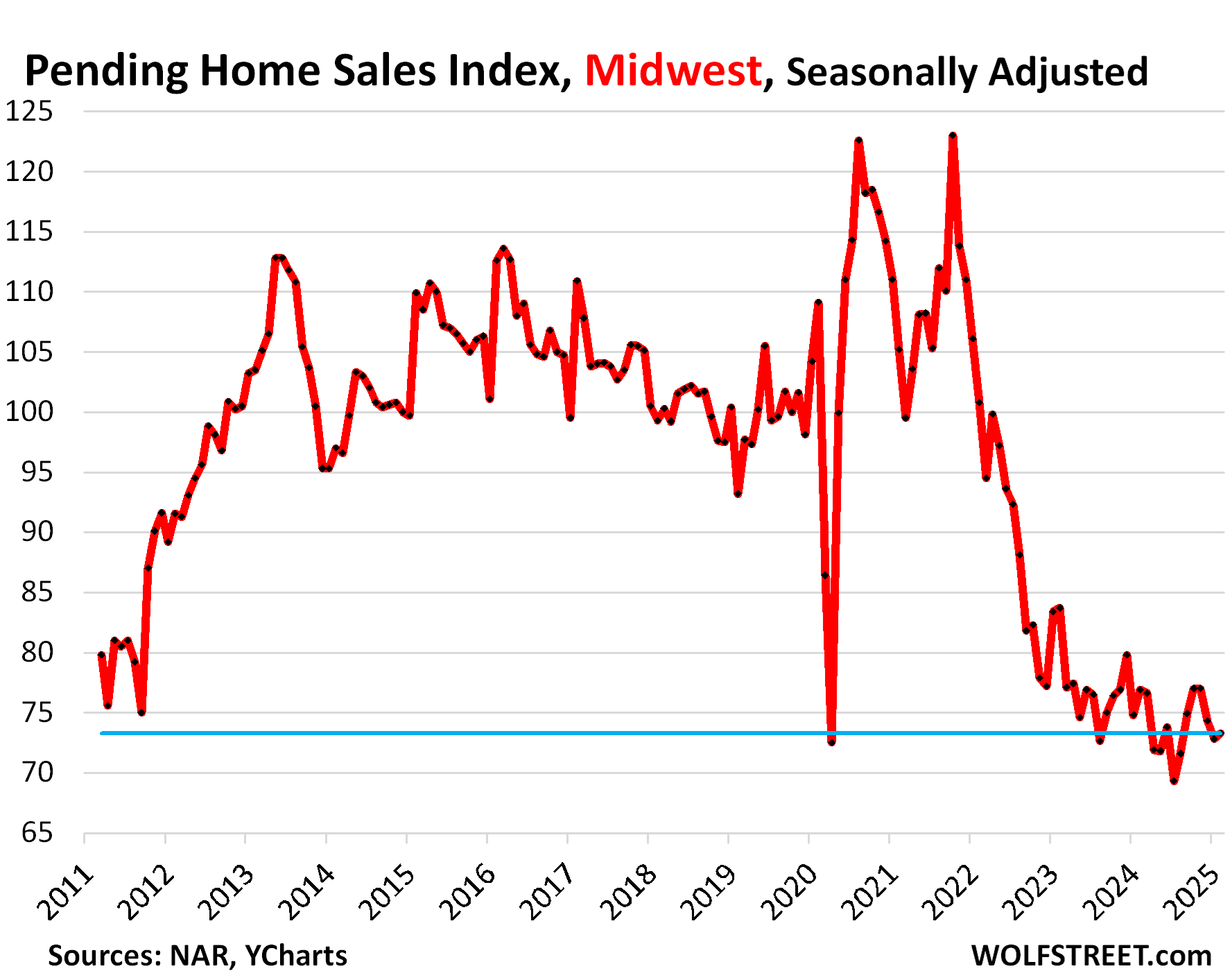
Enjoy reading WOLF STREET and want to support it? You can donate. I appreciate it immensely. Click on the mug to find out how:
![]()


Reminds me of that Bay Area bubble website from years ago.
Reminds me of the bubble ending in 1956, at which point dad had 3 properties and had to sell off 2 cheap, to keep the family home.
Didn’t work out well.
Note to ”young folx”,,, BEE careful, really really careful regarding buying ANY RE until this situation, especially including the political situation ”calms down.”
Wish I could tell you when that will happen, but JP Morgan, possibly the most profitable speculator, gave clear advice:
”No one can predict market highs or lows: so buy on the way down IF you know you can hold though the bottom,,, and sell on the way up knowing you can never know in advance the market top”
OF COURSE he had superior communications, but that does not change the wisdom.
The four Census Regions of the US:
“Even the best laid battle plans fall apart at first contact with the enemy”. Writing from Portland OR. I was renting and trying to ride out the correction. I had no intention of buying. My landlord sold the condo i was renting and I couldn’t touch anything comparable from rental perspective. Low rental inventory for homes not built in the 1920s, outrageous HOAs on new condos driving up rental prices.
I ended up buying last spring and taking the win on the mortgage interest deductions. Still pretty happy i didn’t buy at the peak hype cycle in ’21, ’22
Marry the price and date the rate!
Everyone always thinks rates will decrease and housing prices will increase after they have purchased.
As long as you can afford the current rate and price, and expect to hold on for 12-15 years enjoying your home, you will do fine. From Wolf’s charts, home prices ALWAYS appreciate at least with inflation.
A bonus would be a drop in interest rates to refi.
A relative is selling their house in inland CA. They purchased in 2006 at the last peak and according to Zillow, the house finally went above water in 2018. 12 years. After enjoying the home for 19 years, they are ready to downsize with about 40K in capital gains(after 6% fees and commissions) .They were lucky they could refi 5 years ago but pulled some money out for improvements so their gains are less than ideal.
Patience wins the game.
Lol, because people never have income volatility?
I think you’re married to both the price and rate… Kinda the point of the article
What other attributes would you look at?
Of note, Florida had 400k listings in early 2009, so we are half way there.
Except technology has really sped up the real estate sales chain of action.
So, not quite an apples to apples comparison.
yeah, it makes it worse for people trying to sell. people nervous about their values who were holding on because “houses only go up” but who really wanted to sell see everyone else listing, because of said technology, and start listing theirs too.
I wonder if looking at the percent of pending sales that fall apart would be useful, as a possible measure of unrealistic expectations over reality. I recall, in the past, once a house went pending, it almost always was sold. Where I live, SF Bay Area, it seems like people are a lot nuttier since Covid, and even more nutty since January 20, 2025. This is on a base of high nuttiness to begin with.
Lol, maybe theres a vaccine for that!
You can add Wolf to that ‘Nutty’ list. 😁
Wolf,
You’ve got the last two charts reversed.
It hardly makes a difference, since they
are nigh identical. The charts are labeled
correctly and seem fine, they are just
placed in the wrong section of text.
Yes, thanks.
“Not in my neighborhood .. there’s still bidding war and lines out the door to buy“ proclaim by almost everyone in LA, OC and SD… Probably not as many from IE though or at least not as loudly…
Florida just left that chat…
Same in parts Wyoming and parts of Colorado. Good stuff moving fast. Fix up and overpriced units hang around forever.
exactly. it seems right now if you have a beautiful property & a great price, it will move. Everything else is doomed.
Housing prices, Case Shiller, increased by 52 percent from Jan 2020 to Jan 2025. The CPI increased by 24 percent during the same period. So, any drop in housing should be limited by the drop in the CPI, overall prices or by 28 percent ??
Why do you think so ?
Home prices has nothing to do with CPI. CPI takes into account the asking rents not the home prices.
Prices can go down a lot with record unaffordability and if and when a recession comes.
Most of my friends are sitting on multiple homes thinking this too shall pass, may be true but the bigger picture is not looking pretty.
That’s not how percentages work on the way down vs way up.
Ex – a 50% increase goes to breakeven after a 33% decrease – 100 + 50 = 150 (+50%). 150 – 50 = 100 (-33%).
But your premise holds, there is a floor there somewhere, likely well above 2019 levels. My mildly informed expectation is sideways or mild deflation (low single digits) until we intercept the pre-2020 trendline
Why assume 2019 is a reliable baseline? Prices in 2019 were already elevated by years of rate suppression and QE.
There’s no telling where the floor is in a non QE world. That’s why I believe this Fed doesn’t have the discipline to go there. I’m betting we might see QE again. Part of my portfolio is geared for that.
i hope you’re wrong, but i fear you may be right. people have congratulated the fed for doing so much since 2022. but they’ve been able to do it painlessly, meaning stonks and housing are still at record highs or near them, unemployment is low, and inflation looks under control (but it really isn’t).
the true test is what they’ll do when things are bad. it’s easy to do the right thing when there are no negative consequences to doing so.
Number of pending home sales only speaks to liquidity and depth of the market. However, prices are not being adjusted in any significant manner. With higher interest rates increasing the cost of capital, affordability has been diminished significantly. As such, either rates need to come down or prices. However, while the economy chugs along, we can be in a prolong drought for worthwhile deals.
Wolf has pointed out that today’s housing “prices” do not reflect massive incentives like rate buy downs, free upgrades, etc.
Unrelated but wondering how tariffs on auto parts will translate to additional services inflation. Seems easy enough for importers to pass on costs to repair shops who will pass on costs to insurance companies who will pass on those costs to consumers.
Glen
And in each step look for some markup. Get ready for some serious inflation. Gold is telling you everything you need to know. ENJOY!
Was nice to fuel the work truck for under $3gal. this week ( diesel ).
It would be a minuscule portion because that 25% tariff is based on the cost of the price at the Mexican factory to the importer. Then the huge profit margins are added on to spare parts, all the way through to the dealer. So when the dealer charges $120 for the part and $300 for labor and $15 for miscellaneous shop supplies, the customer gets a $435 repair ticket. But that part bought by the pallet or container might have cost the importer only $30. And a 25% tariff on $30 amounts to $7.50. So if the cost gets passed on, and if supply chains don’t shift to a US-made part, then the repair ticked will rise by $7.50, from $435 to $442.50, that’s a 1.7% increase, much less than normal inflation on parts and labor.
Surging inventories?
Catering sales?
Highest mortgage rates in 15 years?
If only there was a way to predict how this will end with historical data…
I sense a growing number if people are viewing renting as a viable option now that prices have settled down and fear of significant price rises has diminished
Right now, my biggest fear would be having my nestegg in an overvalued home that is too large and outdated. I believe such homes are going to drop like flies from this point forward. Families have gotten smaller. RE tax and insurance are skyrocketing. Who needs that ball and chain plus $100-200k in kitchen, bath, and other upgrade costs to boot.
that’s because, regardless of what real estate shills say about renting, and landlords passing on costs, ultimately rents are a function of available incomes in the area. sale prices are a function of available credit and out of town investment.
salaries still haven’t increased enough that rents can continue to rise significantly every year.
Correct. A quick look at what happened to rent v but calculations tells the story. In my area, the monthly payment for renting a home is 3x cost to buy with a mortgage.
a lot of places are like that. one thing is for sure. if you bought at peak pricing in a bubble market like denver, austin, miami, nashville or ones like that, you cannot cover your costs with rent.
It sounds like a match made in heaven.
You can only put so many silly putty or super glue patches on the dam before it turns into a flood of epic proportions. Don your life vests!
Funny thing is we are currently in what many people would think of as ‘status quo’. It’s not. What we are currently experiencing is a manipulated market, on life support. Market forces will eventually prevail.
Trump signed an executive order today creating a “safe and beautiful” task force to clean up DC. That is going to make a big difference along with all the WFH slackers reporting back to their offices and doing some real work for a change. We noticed condos selling like hotcakes. Even marginal properties are selling for full price. There’s no recession here. The bars are packed as well. We did a condo the other day where there was hard evidence of a hooker doing her thing right at the entrance to the 4 unit condo. A pair of $400 dress shoes was left right at the entrance. The unit sold for full price anyway.
…a Potemkin village by any other name…
may we all find a better day.
The mortgage interest rates are still far too low. Perhaps with Germany poised to issue hundreds of billions of dollars of AAA debt and a debt/GDP about half of the USA; perhaps some of that mortgage money can find a better home in Germany.
Inventory definitely up in Lo Angeles. The zip codes in the expensive west side hills areas —not the Palisades, which was mostly destroyed—have a huge number of listings. 90049 (Brentwood) has 148 single family homes for sale and 90077 (Bel Air) has 105 homes for sale. I suspect fire insurance rates (if you can even get it) has something to do with it. If you end up in the CA Fair plan the cap is $3 million. And 99% of these homes are listed for more than $3 million dollars. Very few under $5 million. Lots above $10 million. Days on market must be astronomical. But still very few price cuts.
Down in the flats where I rent still lots of aspirational pricing. If the house is really nice (updated and good location) they’re selling, sometimes for over asking. Everything else just sits.
that’s true in florida and austin too. the brand new ones or ones that have been nicely renovated sell for peak pricing, or close to it. anything else sits.
it’s funny, the $1 million homes in 2019 that are now $2 million have an easier time selling than the $500,000 homes in 2019 that are now $1 million.
Btw, maybe I am hallucinating or out of my mind but I remember someone posted houses in Carlsbad still getting overbid $250K over asking in her hood…I got a good laugh out of it, either RE agents working OT spamming this board or AI got a hold of things now…cause if that’s still real, then SoCal market is truly insane beyond rescue..
Then again that post is no longer around perhaps Wolf banish it back to RE spam hell hole and deleted the post. Nevertheless, good laugh from it especially after I posted someone will proclaim things are different in OC/LA and SD loudly..
Jim Cramer was on CNBC this morning talking about the tariffs on auto parts. He said the tariffs will raise the cost of a new car by $4,100. Auto parts will be out of sight. Engines and transmissions are all made in Germany, Hungary, and Mexico and get hit by the tariffs. The consumer will get screwed. But he said the alternative is worse. We were giving all of our manufacturing away. We were turning into an assembly only country. Already, 50% of the content of cars built in America are foreign made. Add that half our cars are imported and you’re looking at 1/4th the content of cars sold in the USA is made in America. The repair bills, auto insurance, maintenance contracts, rent a car rates, UBER, and transportation in general will all go up. ENJOY
Cramer is a great entertainer and a clueless idiot promoting BS.
You voted for this too, enjoy!
Bet the opposite of what Cramer tells you and you’ll have way better odds of hitting it big than blind gambling, this is a “proven” rule time and time again since even before 2008. He is the embodiment of opposite rule made famous by George Constanza
Larry Kudlow just said the WH is consideration of a tax INCREASE for the rich, to quiet down the Bernie Sanders wing of the Dem party. What’s going on here? Tax cuts bogged down in Congress. Tariffs going into affect NOW. US going bankrupt in August. Wall street crashing. Gold going to $4,000, Silver to $50/ounce. Looks like Trump won the election on the economy, but we got Jimmy Carter 2.0. and a continuation of the bloated Biden/Pelosi budget and spending levels.
Given the excess supply, why haven’t we seen more construction layoffs yet?
Because homebuilders are NOT slowing down. They’re being aggressive, building homes, cutting profit margins, and making deals.